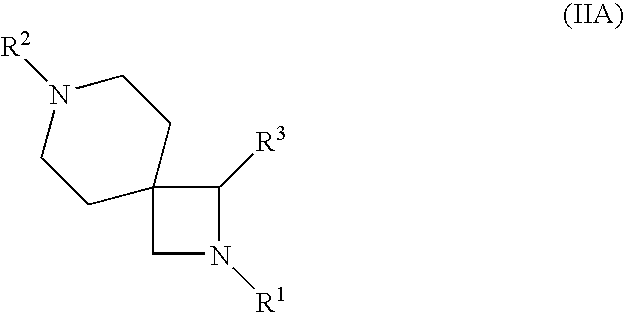Azetidine derivatives useful in treating pain, diabetes and disorders of lipid metabolism
a technology of lipid metabolism and azetidine, which is applied in the direction of phosphorous compound active ingredients, metabolism disorders, peptide/protein ingredients, etc., can solve the problem of failure of pancreatic beta-cells
- Summary
- Abstract
- Description
- Claims
- Application Information
AI Technical Summary
Problems solved by technology
Method used
Image
Examples
example 1
Preparation of 1-(4-Chlorophenyl)-N-cycloheptyl-2-isopropyl-2,7-diazaspiro[3.5]nonane-7-carboxamide, Hydrochloride
[0417]
Step A: Preparation of 1,1-Dimethylethyl 1-oxo-3-(4-chlorophenyl)-2,7-diazaspiro[3.5]nonane-7-carboxylate (2)
[0418] In a dry 250 mL, 3-necked flask, add 4-chlorobenzaldehyde (6-51 g) and dry THF (20 mL) and cool to −30 C. Add 1M lithium bis(trimethylsilyl)amide in THF (47 mL) dropwise keeping the temperature at ˜30 C. Then, warm the reaction mixture to 0 C for 30 min. (Solution A)
[0419] In a dry 250 mL flask, under a nitrogen atmosphere, add diisopropylamine (6.1 mL) and dry THF (10 mL) and cool to 0 C. Add 2.5 M n-butyl lithium in hexane (17.4 mL, 43.5 mmole) dropwise and let stir at −60 C for 25 min. Then, add a solution of ethyl 1-tert-butoxycarbonylpiperidine-4-carboxylate (1) (9.3 g) in dry THF (10 mL) dropwise maintaining the temperature at −65 to −55 C for 90 min. (Solution B)
[0420] Add solution A to solution B dropwise maintaining temperature at −55 to ...
example 2
Preparation of 1,1-Dimethylethyl 1-(4-chlorophenyl)-2-cyclopropyl-2,7-diazaspiro[3.5]nonane-7-carboxylate (10)
Step A: Preparation of 1,1-Dimethylethyl 1-oxo-3-(4-chlorophenyl)-2-cyclopropyl-2,7-diazaspiro[3.5]nonane-7-carboxylate (9)
[0427]
[0428] Under a nitrogen atmosphere, react 4-chlorobenzaldehyde (14.0 g) and cyclopropylamine (5.7 g) in anhydrous toluene (50 mL) in the presence of molecular sieves for 48 h. Filter the reaction mixture and concentrate the filtrate in vacuo at 60 C to give 4-chlorobenzylidene cyclopropylamine (By as a crystalline solid (15.98 g).
[0429] Cool to 0 to −10 C, a solution of diisopropylamine (6×0 mL) in THF (10 mL) and add n-butyllithium (2.5 M, 16.6 mL) dropwise. After 1 h, the reaction mixture was cooled to −78 C. Add a solution of ethyl 1-tert-butoxycarbonylpiperidine-4-carboxylate (1) (10 g) in anhydrous THF (20 mL) dropwise, and stir the resulting solution at −78 C for 1.5 h. Add 4-chlorobenzylidene cyclopropylamine (8) (6.69 g) in THF (40 mL) a...
example 2a
2-{[1-(4-Chloro-phenyl)-2-cyclopropyl-2,7-diaza-spiro[3.5]nonane-7-carbonyl]-amino}-3-methyl-pentanoic acid methyl ester
[0432]
[0433] Treat the compound from Example 2 with TFA according to the procedure of step D in Example 1 and treat the resultant product from this reaction with (2S,3S)-2-isocyanato-3-methylvaleric acid, methyl ester according to the procedure Example 1 step E to give the title compound which is characterized by LCMS. (MWT 448).
PUM
| Property | Measurement | Unit |
|---|---|---|
| pharmaceutical composition | aaaaa | aaaaa |
Abstract
Description
Claims
Application Information
 Login to View More
Login to View More - R&D
- Intellectual Property
- Life Sciences
- Materials
- Tech Scout
- Unparalleled Data Quality
- Higher Quality Content
- 60% Fewer Hallucinations
Browse by: Latest US Patents, China's latest patents, Technical Efficacy Thesaurus, Application Domain, Technology Topic, Popular Technical Reports.
© 2025 PatSnap. All rights reserved.Legal|Privacy policy|Modern Slavery Act Transparency Statement|Sitemap|About US| Contact US: help@patsnap.com



